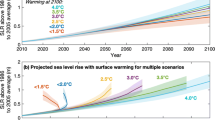Abstract
Accelerated sea-level rise and the effects on coastal areas represent one of the most important impacts of global climate warming as a large part of the world's population and food production is situated along low-lying coasts. Coastal nations of the world should now be planning for one-half to a meter rise in sea level during the next century. While the actual extent of sea rise realized may be larger or perhaps smaller, this amount establishes a reasonable baseline for coastal zone planning activities. With respect to actual measures, priority should be given to projects that are beneficial to presently existing problems in coastal areas.
The lowlands along the world's seas will be the areas most vulnerable to impact. They include the deltaic, barrier island, atoll, and marshy coastlines. Increased storm-induced flooding represents the major danger in developing countries because of loss of life. In western countries, beach erosion will be a primary concern, requiring substantial expenditure of public funds to maintain existing recreational beaches. Marshlands will probably be left to their own destiny, which signals a marked decline in most places.
The responses to accelerated sea-level rise must be based on more than a simple cost-benefit ratio; a host of important considerations cannot be expressed in simple dollar terms. Each area must be considered on a site-specific basis as there is considerable geographic variation in the environmental (e.g., hydrologic, geologic) and cultural (e.g., population, human development) factors. The problem is further compounded by the time lag of several decades that exists between public recognition of the problem and actual construction and full operation of major coastal protective devices. It may be necessary to retreat from the eroding shore in some areas, while fortifying and even reclaiming land in others. Clearly a global response is required in that international research and cooperative efforts represent the only reasonable approach.
Similar content being viewed by others
References
Bird, E. C. F.: 1985, Coastline Changes - A Global Review, Chichester, Wiley Interscience, 219 pp.
Bird, E. C. F.: 1986, ‘Potential Effects of Sea Level Rise on the Coasts of Australia, Africa and Asia’, in Effects of Changing Stratospheric Ozone and Global Climate, Volume 4, EPA/UNEP, Washington, D.C., pp. 83–98.
Bruun, P.: 1983, ‘Review of Conditions for Uses of the Bruun Rule of Erosion’, Coastal Engineering 7, 77–89.
Delft Hydraulics: 1987, Impact of Sea Level Rise on Society Position Papers and Consistency Model.
Delft Hydraulics: 1989, Criteria for Assessing Vulnerability to Sea Level Rise: A Global Inventory to High Risk Areas, UNEP report, in progress.
Environmental Protection Agency: 1988, The Potential Effects of Global Climate Change on the United States, Report to Congress, Washington, D.C., 51 pp.
Gehrels, R. and Leatherman, S. P.: 1989, Sea Level Rise: Animator and Terminator of Coastal Marshes, Vance Bibliography, Monticello, Illinois, 39 pp.
Goemans, T.: 1986, The Ongoing Dialogue of the Dutch with the Sea, UNEP/EPA International Conference on Health and Environmental Effects of Ozone Modification and Climate Change, Crystal City, Virginia.
Jaeger, J.: 1988, Developing Policies for Responding to Climatic Change. A Summary of Discussions and Recommendations of the Workshops held in Villach (1987) and Bellagio (1987) under the Auspices of the Beijer Institute, Stockholm, Sweden, WMO/TD, No. 225, World Meteorological Organization and United Nations Environment Programme.
Leatherman, S. P.: 1983, Geomorphic Effects of Projected Sea Level Rise: A Case Study of Galveston Bay, Texas, Proceedings of Coastal Zone 83, ASCE, San Diego, CA, pp. 2890–2901.
Leatherman, S. P.: 1986a, Shoreline Response to Sea Level Rise: Ocean City, Maryland, Proceedings of Icelandic Conference on Coasts and Rivers, Reykjavik, Iceland, pp. 267–276.
Leatherman, S. P.: 1986b, Impacts of Sea Level Rise on the Coasts of South America, Effects of changes in Stratospheric Ozone and Global Climate, UNEP-EPA Report, Washington, D.C., pp. 73–82.
Leatherman, S. P.: 1988, National Assessment of Beach Nourishment Requirements Associated with Accelerated Sea-Level Rise, U.S. Environmental Protection Agency Report, Washington, D.C., 74 pp.
National Research Council: 1987, Responding to Changes in Sea Level: Engineering Implications, National Academy of Sciences, Washington, D.C., 148 pp.
Vellinga, P.: 1986, Beach and Dune Erosion during Storm Surges, Delft Hydraulics Laboratory publication No. 372.
Vellinga, P. and Zitman, T. J.: 1988, Sea Level Rise and Morphological Modelling, Internal Report Delft Hydraulics, Emmeloord, The Netherlands.
Waterman, R. E.: 1988, Integrated Coastal Policy Via Building with Nature, Ministry of Transport and Public Works, The Netherlands.
Author information
Authors and Affiliations
Rights and permissions
About this article
Cite this article
Vellinga, P., Leatherman, S.P. Sea level rise, consequences and policies. Climatic Change 15, 175–189 (1989). https://doi.org/10.1007/BF00138851
Received:
Revised:
Issue Date:
DOI: https://doi.org/10.1007/BF00138851




